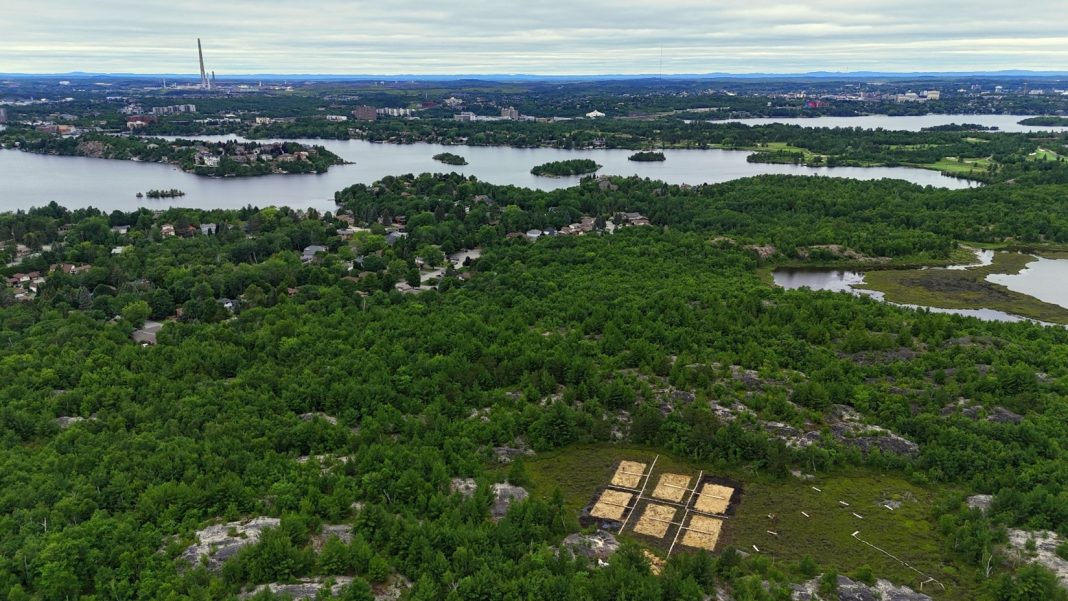Professor Pete Whittington discusses efforts to restore metal-contaminated peatlands in Sudbury, Ontario, which were heavily affected by mining since the 1880s
Nickel and copper mining began in Sudbury, Ontario (approximately 400km north of Toronto, Canada) in the 1880s, resulting in enormous atmospheric emissions of sulphur and metal particulates that acidified thousands of lakes and destroyed vast areas of vegetation cover in and around the city. In the early 1960s, Sudbury’s smelters represented the largest point source of sulphur dioxide in the world, accounting for 4% of global emissions. Along with the SO2, tens of thousands of metric tons of potentially toxic elements, such as copper, nickel, and arsenic, were also emitted. The resulting barren landscape was an environmental crisis. In the 1970s and 1980s, changes to legislation and advancements in industrial technologies significantly reduced air pollution in Sudbury, resulting in a 98% reduction achieved to date.
Regreening of Sudbury
The Sudbury Regreening program (beginning in 1978) is a world-famous restoration success story, which so far has reclaimed roughly 50% of the landscape. The forest restoration process involves spreading crushed dolomite on the soil surface to increase the pH, followed by the application of a phosphorus-rich fertilizer, a grass- legume seed mixture, and the planting of up to 75 species of tree and shrub saplings to encourage vegetation growth. In 2022, the Regreening Program was honoured to host Dr. Jane Goodall and then-Canadian Prime Minister Justin Trudeau to plant the ten millionth tree. The Sudbury Regreening program was also featured in the IMAXTM film ‘Jane Goodall: Reasons for Hope’ (2023).
With the Regreening of Sudbury well underway, and the hundreds of lakes in the region on their way to recovery, attention has shifted to restoring the peatlands (organic wetlands) in the landscape, which have received little attention. Despite occupying only 14% of the area, peatlands are the densest store of carbon in the region. However, due to years of atmospheric contamination, most of the carbon sequestering vegetation (Sphagnum moss) is dead. Some peatlands have lost more than 1,500 years of stored carbon. Additionally, these contaminated peatlands are increasingly fire-prone during hot summers, putting the stored metals and carbon at risk of catastrophic release.
Prioritising climate-change initiatives
In 2022, the Canadian Federal Budget prioritized Canada’s ongoing efforts to combat climate change by taking bold and immediate action to reduce greenhouse gas emissions. Our project, ‘Mining atmospheric CO2: Assessing the efficacy of novel carbon sequestration strategies in smelter-damaged ecosystems to achieve net zero GHG emissions,’ was among those funded.
Our restoration approach is based on a world-renowned peatland restoration method, developed at Laval University in Quebec, Canada, called the Moss Layer Transfer Technique (MLTT). Briefly, this technique was developed to restore peatlands that had been extracted for horticultural use.
The process involves spreading donor moss materials on the surface of the extracted peatland and covering it with straw mulch to prevent the moss from drying out. Extracted peatlands are typically quite dry, and obtaining sufficient water on-site is the primary challenge. These extracted peatlands, where the MLTT was developed, are NOT contaminated, unlike those in the Sudbury region.
The differences we face are not related to water availability, but rather to the chemistry of peatlands. Peatlands are very good at holding onto the metals that cause the carbon-storing Sphagnum to die. Additionally, the vegetation that has survived in the contaminated Sudbury peatlands does a poor job at combating climate warming. So, while the peatlands may look like intact functioning peatlands, they are not.
Our project has selected a small section of one of Sudbury’s most contaminated peatlands and divided it into six areas (roughly 8 x 12m), where three different restoration approaches (treatments) were applied (each with a replicate).
At all three treatments, we removed most of the existing shrub vegetation to ensure that the material we applied reaches the surface of the peatland and doesn’t get caught in the shrubs.
The first treatment applied a 5cm layer of ‘buffer’ peat to act as a chemical buffer, isolating the donor moss from the contaminated peatland below; this left a surface nearly identical to that produced by the traditional MLTT in extracted peatlands. The second tilled the surface of the peatland to break up the contaminated peatland’s surface, replicating the MLTT process, but not the surface conditions (no buffer peat). The third looked towards the future by simply leaving the peatland surface mostly ‘as is’, applying only the donor material and straw mulch, which operationally is the easiest and cheapest option.
Once the surface preparation was completed, all plots were covered with a ~1cm layer of donor Sphagnum moss material and then with a 3-5cm layer of straw mulch to prevent the donor moss material from drying out, followed by a layer of rock phosphate fertilizer.
Our students spent July and August 2024 and summer 2025 monitoring the restoration trials, including taking measurements and characterizing the vegetation composition and greenhouse gas fluxes. We expect to see the first meaningful field results 2-3 years after the restoration application. We are also conducting greenhouse and lab experiments at Nipissing, Saint Mary’s, and Lakehead Universities, where we are already gaining insights into the underlying chemical, ecological, and microbiological mechanisms of the historical impacts, as well as our future restoration approaches.
The investigators would like to thank NSERC for its funding, the City of Greater Sudbury, and Vale as important project partners. We also thank Frédéric Caron and Premier Tech for donating all of the restoration materials (peat and donor moss).


